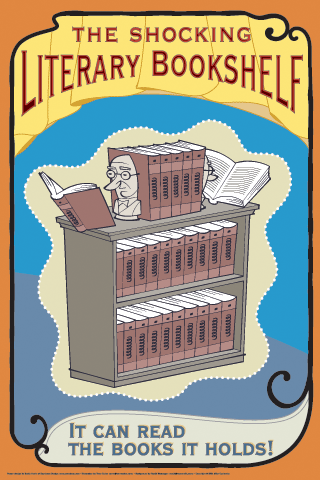July 22, 2004
Smart Furniture Side Show, Part 1
Here's an edited version of the text I gave during my "Smart Furniture Side Show" talk at 2ad . I wrote a bit about it a couple of months, but it's taken me a while to post what I had talked about, especially since all I had there was an outline and ended up adlibbing the talk a little differently each of the 20 or so times I gave it. There's bunch of it, so I'm going to post it in several pieces, including the awesome posters that Terry Colon and Sonia Harris did for me. If you want awesome illustration and design (for conferences posters or otherwise), hire them.
The Smart Furniture Side Show!
Ladies and gentlemen! Boys and girls! Step right up! Come gaze at this emporium of technological mutation. A chair that walks! Walls that talk! A bed that knows when you're awake...and when you're asleep. Come see the Smart Furniture Side Show, and don't be afraid of what you will see inside—well maybe just a little...OK, enough of that.
In the last 10 years there has been a lot of discussion about ubiquitous computing, pervasive computing and ambient intelligence. Most of this discussion has focused on creating new objects and appliances that require learning unfamiliar modes and failure states that make them useless when they're not doing the new thing they're supposed to be doing. For the most part, they're wholly separate devices that we're supposed to incorporate into our daily existence--and that's hard.
My thesis is that there are few things that are more ambient, ubiquitous and pervasive than furniture. Furniture is already all around us. It defines our spaces, supports our work and play, and gives us tools with which to express our values. This makes furniture a great platform for augmenting people's existing use modes with information processing without adding to what they need to know. Smart furniture is an evolutionary step that softens the edge of technology adoption for the consumers and allows technology producers to understand which directions are most fruitful for taking ambient/pervasive/ubiquitous computing.
In other words, why create new objects when there is a world of existing things that can be made better, things that people already know how to use?
Let me give you some examples:
The Literary Bookshelf

Let's start with a bookshelf and books. Imagine that the bookshelf has RFID readers embedded into the shelf and the books have each been stickered with RFID tags (it would be trivial for Amazon to ship all of their books with RFID tags in them, I suspect). Imagine that there's also a way to identify a book or books, either through some kind of lighting with LEDs or maybe something more bookshelf-like, with little pieces of wood that are stained different colors and which can flip, like one of those railroad signs in Europe. What can you do with this extension of the bookshelf and books? Well, first of all you never have to loose a book again. That's the obvious utility: "Hey, where my copy of Stephanie Winston's Best Organizing Tips?
Fine. But there's a more interesting thing. Imagine linking this bookshelf to Amazon.com's database (or some database built on top of Amazon.com's database, or the Library of Congress database…something that has the appropriate metadata). You can ask a bunch of new questions of your bookshelf:
- "What books do I own on this topic? Please light them with brightness proportional relevancy."
- "What books do I own that address these two topics? Use different colors to show me which books have which topic."
- "There's some book that has some variation of this quotation in it, which one is it?" (using the "Search in this book" functionality)
- "Which of my books reference this book?"
And still more interesting are questions like
- "Which of my friends has books like this (that they're willing to tell the database about)? "
You can then expand this idea to a system of objects, using the book RFID tag in new ways: a smart book jacket with a small keyboard and display that, based on the RFID tag, downloads the full text when placed around the book, allowing you to search inside the book, etc. Or using the RFID bookshelf in new ways: misfiling books in a library would immediately become more difficult, etc.
[to be continued tomorrow]
Posted by mikek at July 22, 2004 09:57 PM | TrackBack